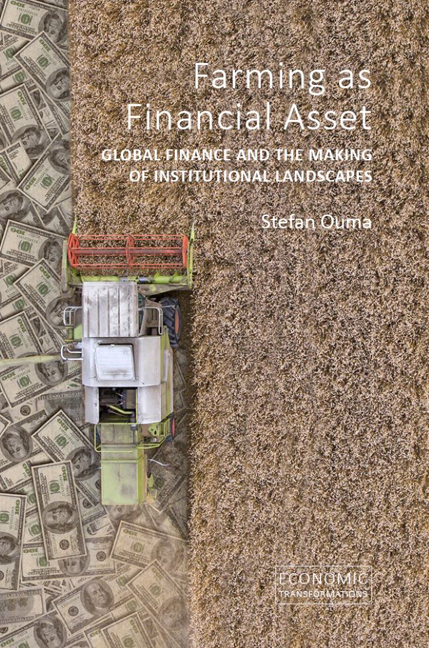Book contents
- Frontmatter
- Contents
- Preface
- Acknowledgements
- List of illustrations
- 1 Introduction
- 2 Optic: how do we study the finance– farming nexus?
- 3 History: how old is the finance– farming nexus?
- 4 Numbers: what we know (and do not know) about finance-gone-farming
- 5 States: how are foreign investments in farming regulated and accounted for?
- 6 Value(s): why has the road to “greener pastures” been so bumpy?
- 7 Delegation: what happens inside the agri-investment chain?
- 8 Grounding: what does assetization look like from below?
- 9 Radices: food futures, with or without finance as we know it?
- Epilogue
- References
- Index
3 - History: how old is the finance– farming nexus?
- Frontmatter
- Contents
- Preface
- Acknowledgements
- List of illustrations
- 1 Introduction
- 2 Optic: how do we study the finance– farming nexus?
- 3 History: how old is the finance– farming nexus?
- 4 Numbers: what we know (and do not know) about finance-gone-farming
- 5 States: how are foreign investments in farming regulated and accounted for?
- 6 Value(s): why has the road to “greener pastures” been so bumpy?
- 7 Delegation: what happens inside the agri-investment chain?
- 8 Grounding: what does assetization look like from below?
- 9 Radices: food futures, with or without finance as we know it?
- Epilogue
- References
- Index
Summary
Historically, finance capital has adopted many forms in promoting change in both farm structure and landowning relations.
(Munton 1985: 156)In September 2014 the Queensland Art Gallery and Gallery of Modern Art in Brisbane hosted an exhibition called “Harvest”, which engaged with the history, geography, production and politics of food in the Australian state. The exhibition featured a collection of photographs by Richard Daintree, one of the first Britons to explore the region. A geologist and photographer, he took some impressive pictures of the region's landscape (such as Photo 3.1), which he presented, together with geological maps, at the 1862 International Exhibition in London in a bid to attract immigrants and investors to the colony (entry in field diary 2014). Across the Tasman Sea, some 40 years earlier, whaling and shipping interests began to pitch Aotearoa New Zealand as a new frontier for British colonization. A proposal for a military colony in the North Island from 1823 sketches a promising investment case, highlighting its “delightful climate … uncommon fertility of soil, [which gives] … all the necessaries and most luxuries of civilized life … [T] here is no country on earth more favourably circumstanced for the operations of agriculture than New Zealand” (McAloon 2013: 86). Back then, pictures and some text were enough to mobilize capital for agricultural ventures from abroad.
These snapshots can be juxtaposed with the investment prospectuses of capital-raising agricultural fund managers some 150 years later. Speaking to potential investors, these similarly pitch promising landscapes across a range of geographies, albeit now backed up with hard figures and fancy graphs. When placed into that historical lineage, a phenomenon that many media, research and activist reports have hyped as the outcome of the financialization of the economy starting in the 1970s (Harvey 2007; McMichael 2012), suddenly appears less novel. Metropolitan finance has a long history of helping to transform nature into property in different parts of the world, producing and reshaping agrarian landscapes via the provision of both debt and equity capital.
- Type
- Chapter
- Information
- Farming as Financial AssetGlobal Finance and the Making of Institutional Landscapes, pp. 25 - 44Publisher: Agenda PublishingPrint publication year: 2020



